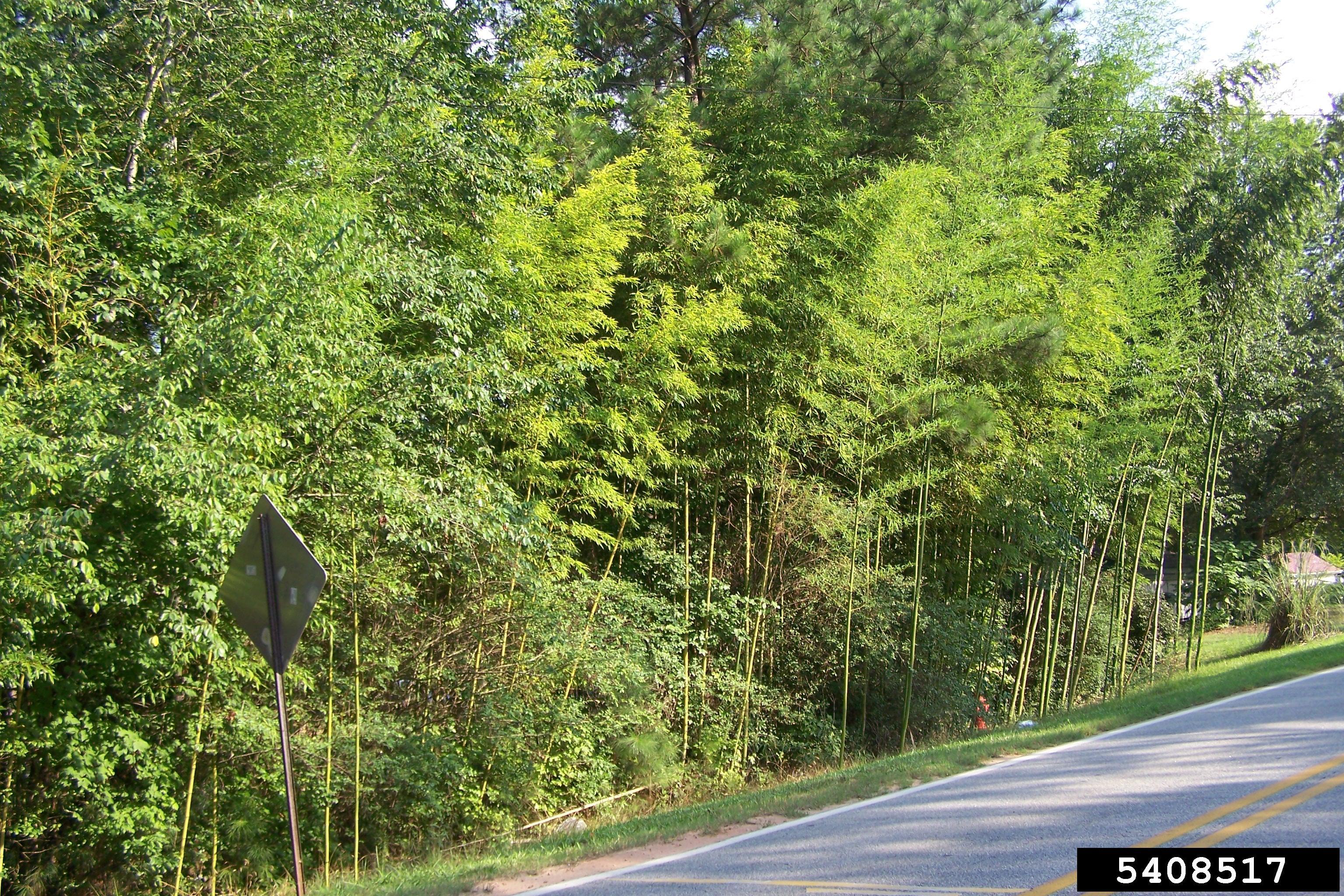Golden bamboo, also known as fishpole bamboo or running bamboo, is an invasive plant that was introduced to North America over a century ago and is still offered for sale as a fast-growing ornamental plant.
What is it?
Golden bamboo (Phyllostachys aurea) is native to southeast China, and has been cultivated in Japan for centuries. It was first introduced to the United States in 1882 at a site in Alabama. It became a popular choice for property owners wishing to develop a screening and/or noise barrier. Others planted it with the intention of harvesting them for fishing poles.
Since its first arrival, it has escaped from its original planting sites in the southeast, spreading from Texas to North Carolina, but it is also cultivated as far north as Buffalo, NY. Scattered escaped populations exist as far west as California and Hawaii; on the island of Oahu, researchers found a one-acre patch on a hillside that has crowded out native species. The patch had grown from a single roadside ornamental planting.
What makes Golden bamboo popular as a planting choice for property owners (in particular, its fast growth in a variety of light and soil conditions) also makes it a challenge for managers if it is not properly contained. It can grow in both open and wooded environments as well as on forest edges. It is now considered an invasive species in Maryland, Pennsylvania, Virginia, West Virginia and Georgia. See the distribution map below.

How does it spread?
As with other species of bamboo, Golden bamboo plants rarely flower or produce seeds; it may be anywhere from 5 to 30 years between events for a stand of Golden bamboo. Instead, Golden bamboo spreads through underground rhizomes which grow quickly, spreading out horizontally from the parent plant. Stems generally emerge in early Spring.
How can I identify it?
Golden bamboo grows as solid jointed canes from one to six inches in diameter. The canes are hollow between the joints and range in color from golden green to deep green to black. They can grow up to 40 feet in height.
The leaves often grow in fan clusters, with long, “lanceolate” blades (elongated ovals that resemble lance blades) that range from 3 to 10 inches in length. See the image gallery below.
How can I control it?
The easiest way to keep Golden bamboo out of an environment is to not plant it in the first place. If control on an existing stand is desired, a combination of cutting, burning and herbicide applications may be required. It is essential that all rhizomes are removed through excavation, as they can continue to grow despite the loss of the above-ground plants. Repeated treatment of the area will likely be necessary to ensure complete eradication.
For more information:
A wide variety of resources exist about Golden bamboo:
Bugwood.org wiki page
Center for Aquatic and Invasive Plants—University of Florida, Institute of Food and Agricultural Services
Golden Bamboo - National Invasive Species Information Center, US Dept. of Agriculture
 English
English العربية
العربية Български
Български 简体中文
简体中文 繁體中文
繁體中文 Hrvatski
Hrvatski Čeština
Čeština Dansk
Dansk Nederlands
Nederlands Suomi
Suomi Français
Français Deutsch
Deutsch Ελληνικά
Ελληνικά हिन्दी
हिन्दी Italiano
Italiano 日本語
日本語 한국어
한국어 Norsk bokmål
Norsk bokmål Polski
Polski Português
Português Română
Română Русский
Русский Español
Español Svenska
Svenska Català
Català Filipino
Filipino עִבְרִית
עִבְרִית Bahasa Indonesia
Bahasa Indonesia Latviešu valoda
Latviešu valoda Lietuvių kalba
Lietuvių kalba Српски језик
Српски језик Slovenčina
Slovenčina Slovenščina
Slovenščina Українська
Українська Tiếng Việt
Tiếng Việt Shqip
Shqip Eesti
Eesti Galego
Galego Magyar
Magyar Maltese
Maltese ไทย
ไทย Türkçe
Türkçe فارسی
فارسی Afrikaans
Afrikaans Bahasa Melayu
Bahasa Melayu Kiswahili
Kiswahili Gaeilge
Gaeilge Cymraeg
Cymraeg Беларуская мова
Беларуская мова Íslenska
Íslenska Македонски јазик
Македонски јазик יידיש
יידיש Հայերեն
Հայերեն Azərbaycan dili
Azərbaycan dili Euskara
Euskara ქართული
ქართული Kreyol ayisyen
Kreyol ayisyen اردو
اردو বাংলা
বাংলা Bosanski
Bosanski Cebuano
Cebuano Esperanto
Esperanto ગુજરાતી
ગુજરાતી Harshen Hausa
Harshen Hausa Hmong
Hmong Igbo
Igbo Basa Jawa
Basa Jawa ಕನ್ನಡ
ಕನ್ನಡ ភាសាខ្មែរ
ភាសាខ្មែរ ພາສາລາວ
ພາສາລາວ Latin
Latin Te Reo Māori
Te Reo Māori मराठी
मराठी Монгол
Монгол नेपाली
नेपाली ਪੰਜਾਬੀ
ਪੰਜਾਬੀ Afsoomaali
Afsoomaali தமிழ்
தமிழ் తెలుగు
తెలుగు Yorùbá
Yorùbá Zulu
Zulu ဗမာစာ
ဗမာစာ Chichewa
Chichewa Қазақ тілі
Қазақ тілі Malagasy
Malagasy മലയാളം
മലയാളം සිංහල
සිංහල Sesotho
Sesotho Basa Sunda
Basa Sunda Тоҷикӣ
Тоҷикӣ O‘zbekcha
O‘zbekcha አማርኛ
አማርኛ Corsu
Corsu Ōlelo Hawaiʻi
Ōlelo Hawaiʻi كوردی
كوردی Кыргызча
Кыргызча Lëtzebuergesch
Lëtzebuergesch پښتو
پښتو Samoan
Samoan Gàidhlig
Gàidhlig Shona
Shona سنڌي
سنڌي Frysk
Frysk isiXhosa
isiXhosa